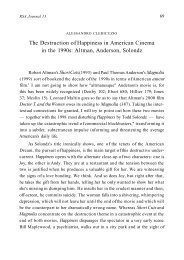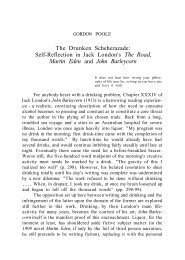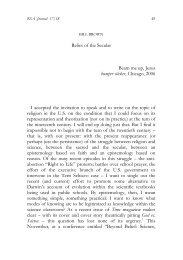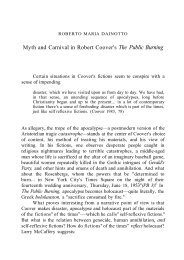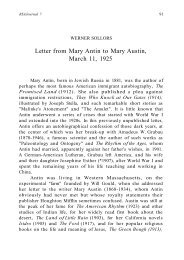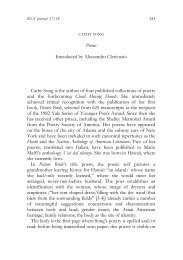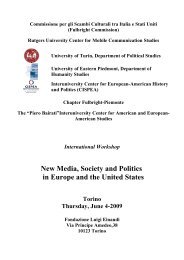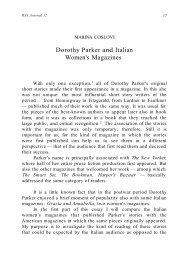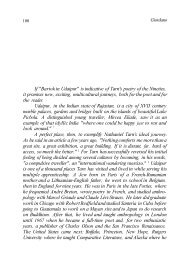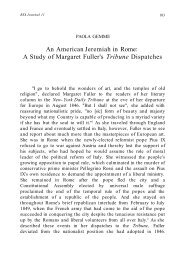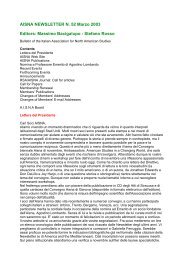Still Life with a Machine: E.E. Cummings's Typewriter Poems - aisna
Still Life with a Machine: E.E. Cummings's Typewriter Poems - aisna
Still Life with a Machine: E.E. Cummings's Typewriter Poems - aisna
Create successful ePaper yourself
Turn your PDF publications into a flip-book with our unique Google optimized e-Paper software.
RSA Journal 14/2003<br />
SALVATORE MARANO<br />
<strong>Still</strong> <strong>Life</strong> <strong>with</strong> a <strong>Machine</strong>:<br />
E.E. <strong>Cummings's</strong> <strong>Typewriter</strong> <strong>Poems</strong><br />
Typography is such a formidable problem that some<br />
poets . . . stay <strong>with</strong> the typewriter and try to make its<br />
peculiar qualities organic to the meaning in their poem.<br />
Mary Ellen Solt<br />
When I was into typewriter concrete, it was as much that<br />
I was into the typewriter as a tool of the writer — as an<br />
extension of the writer.<br />
bp Nichol<br />
1. A Curiosity Breeding Little Joker<br />
When in 1874 Mark Twain bought his Remington Model I, he did<br />
not suspect that the machine invented in 1843 by Charles Thurber<br />
would struggle for popular recognition. Accordingly, when he<br />
consigned to his publisher the printout of Tom Sawyer, he was<br />
probably unaware that the first typescript in the history of literature<br />
was to set a standard for the professional writers to come, as the<br />
mocking note that accompanied the text suggests:<br />
GENTLEMEN: PLEASE DO NOT USE MY NAME IN ANY WAY,<br />
PLEASE DO NOT EVEN DIVULGE THE FACT THAT I OWN A<br />
MACHINE, I HAVE ENTIRELY STOPPED USING THE<br />
TYPEWRITER, FOR THE REASON THAT I NEVER COULD
<strong>Still</strong> <strong>Life</strong> <strong>with</strong> a <strong>Machine</strong>: E. E. Cummings 121<br />
WRITE A LETTER WITH IT TO ANYBODY WITHOUT<br />
RECEIVING A REQUEST BY RETURN MAIL THAT I WOULD<br />
NOT ONLY DESCRIBE THE MACHINE BUT STATE WHAT<br />
PROGRESS I HAD MADE IN THE USE OF IT, ETC., ETC. I DON'T<br />
LIKE TO WRITE LETTERS, AND SO I DON'T WANT PEOPLE TO<br />
KNOW THAT I OWN THIS CURIOSITY BREEDING LITTLE<br />
JOKER.<br />
YOURS TRULY,<br />
SAML L. CLEMENS. (Kittler 192-3)<br />
Thirty-three years later, when the more efficient Model II had long<br />
introduced the flexible lowercase option and the Underwood<br />
company its innovative device for visual control of the output, none<br />
other than Henry James started his second career as the dictator of<br />
his work to Theodora Bosanquet. In the words of Friedrich Kittler,<br />
the most immediate consequence of this memorable event was that,<br />
from then on, the author "shifted his famous, circumlocutionary<br />
style of novel writing toward Remingtonese" (216). That James, who<br />
didn't like the machine on a matter of principle, was soon emulated<br />
by his machine-enthusiast friend Edith Wharton — who, in turn, took<br />
delight in dictating to a male typist — is not surprising. That he fell<br />
victim of "a reflex loop," so that "only the clanking of the typewriter<br />
induced sentences in the writer" (Kittler 216), however, is telling of<br />
the paradigmatic shift brought about in modern times by the new<br />
technological scenario.<br />
In a few years, the belated habit of using typists as mechanized<br />
secretaries was gradually dropped in favor of a more efficient oneto-one<br />
relationship <strong>with</strong> the machine and, but for some notable<br />
exceptions, 1 the typewriter became as indispensable to the writer as<br />
the pen or the pencil had been in the past. Although the latter were<br />
never completely superseded by the former, the image of the<br />
professional writer grew gradually closer to that of the reporter, who
122 Salvatore Marano<br />
exerted an iron-grip control over word-processing, thanks to the fact<br />
that "the advent of the typewriter" brought about "an indication of<br />
how many words will fit on the page" (Smith 12). Out of this<br />
functional approach, which appealed mostly to novelists and<br />
essayists, one figure at the beginning of the century stands out as the<br />
pioneer who employed the machine in the uncharted territory of<br />
poetry almost single-handedly. Although he may not have been "the<br />
first significant poet to compose on a typewriter" (Gioia,<br />
"Manuscripts" 17), by using the machine as his privileged means of<br />
composition Edward Estlin Cummings inaugurated a practice that<br />
would not see any significant development until the advent of<br />
postwar visual and "sound" poetry.<br />
2. The Poet as Typist<br />
Cummings began to experiment <strong>with</strong> his Royal typewriter very soon,<br />
as his pieces in the 1917 Eight Harvard Poets anthology confirm.<br />
Apparently, he was fascinated by the opportunities that the<br />
mechanics of wordprocessing offered to his reflections on prosody<br />
and spacing prompted by the discovery of Pound's "The Return" in<br />
his college years. The young poet, who in a 1957 letter to Charles<br />
Norman still acknowledged the debt to his elder fellow, 2 was<br />
probably struck by the typographical rendition of Pound's peculiar<br />
and, at that time, unusual prosody. According to Richard Kennedy,<br />
to him this "freedom of spacing represented a release from formal<br />
bonds, and he saw, as he sat at the family typewriter trying out visual<br />
arrangements, that there were immense possibilities for<br />
expressiveness in the combinations and the separations of the words<br />
on the page" (107).<br />
Cummings had meanwhile started all sorts of verbal<br />
experiments <strong>with</strong> codes borrowed mainly — although not exclusively
<strong>Still</strong> <strong>Life</strong> <strong>with</strong> a <strong>Machine</strong>: E.E. Cummings<br />
123<br />
— from painting and music. He conceived a system of<br />
correspondences between colors, sounds and the alphabet which,<br />
partly reminiscent of both French symbolist poetry and Apollinaire's<br />
Orphism, soon converged into a highly original conflation of<br />
Scriabin's theory of correspondences, the poetics of the<br />
Synchromists and, of course, Pound's Imagist and Vorticist credo<br />
(Cohen 195-209). As a result of his growing interest i11 the<br />
interrelations of the arts, Cummings started to "subvert all the<br />
conventions of punctuation, capitalization, and syntax" (Kennedy<br />
110) and, between June 1916 and January 1917, "[w]hile he waited<br />
for answers to letters about jobs," he "was free to play <strong>with</strong> his<br />
typewriter and to investigate further all the relationships among the<br />
new arts to which he had so recently been exposed" (Kennedy 115).<br />
Among the formal experiments that didn't find their way to<br />
publication, there is at least one instance of reversed writing order —<br />
i.e., a text whose words are written from right to left — a number of<br />
poems featuring arrangements in vertical or diagonal rows according<br />
to aural correspondences among clusters of vowel and consonant<br />
sounds, and different versions of the same fragments characterized<br />
by the endless relocation. of the lines over the page. These early<br />
samples, which laid down the foundation of <strong>Cummings's</strong> future<br />
experiments <strong>with</strong> the pulviscular aspects of visual composition, have<br />
in common the exhilarating effect produced by the mechanical<br />
spacing of the typewriter on the poet's compositional habits. Far<br />
from being the constrictive prison that its automatic functioning may<br />
suggest, the machine helped the author solve his problems <strong>with</strong> both<br />
verbal disposition and synctactical consistency, two concerns that<br />
accompanied him throughout his career. Not that the writer ever<br />
relinquished manuscript composition; on the contrary, there is<br />
plenty of evidence not only that he conceived diagrams and early<br />
drafts in his handwriting, but also that he often adorned the
124 Salvatore Marano<br />
typewritten text of his poems <strong>with</strong> drawings and calligraphic notes.<br />
In neat opposition to Apoilinaire, 3 however, Cummings consciously<br />
erased all the traces of what Stanley Kunitz would call the kinetic<br />
dimension of writing, 4 and in the end, nothing but the bare<br />
typescripts found their way to publication. With the presence of the<br />
medium so neatly inscribed in the very texture of his work, any<br />
discussion of <strong>Cummings's</strong> typography should start from a survey of<br />
the techniques that he derived from the typewriter. Given for granted<br />
that no taxonomy can effectively do justice to a set of strategies meant<br />
to "prevent the sort of reading which vapourizes words into concepts,<br />
and give his poem the status of objects whose specific features must be<br />
attended to" (Korg 196), it is useful to group all the "visual features of<br />
typography that have no exact equivalents in speech" (Gioia,<br />
"Manuiscripts" 17) in the three broad categories of spacing,<br />
punctuation and lettering — the latter including "lower- and uppercase<br />
letters, visual symbols (like &, $, and %), arabic and roman<br />
numbers ... and abbreviation" (ibid. 17).<br />
3. Spacing<br />
The first thing to consider in the work of a poet and painter is that<br />
the page tends to be used as a canvas and, therefore, as a unit of<br />
composition. Consequently, <strong>with</strong> the exception of some juvenilia,<br />
<strong>Cummings's</strong> poetry almost never stretches beyond the folio. Either<br />
in the traditional form of the sonnet or in the organic format of the<br />
poempicture, his poems are short and, more often than not, have<br />
plain, simple texts. At least at first impact, the reader is startled more<br />
by the idiosyncrasy of his typography than by the use of "deviant<br />
morphology," as Richard Cureton calls the poet's "unhinibited,<br />
consistent, and effective deviation from accepted norms of syntax"<br />
(213 ). Therefore, spacing performs a central role in the service of the
<strong>Still</strong> <strong>Life</strong> <strong>with</strong> a <strong>Machine</strong>: E.E. Cummings 125<br />
mechanical process of visualization, not to mention the fact that,<br />
from a prosodic perspective, it "may be integrative or also<br />
disintegrative in that metrical lines are disrupted or free verse<br />
strophes are distributed over the page" (Friedman 122). Although<br />
from time to time it contributes to the creation of beautiful carmina<br />
figurata, spacing tends to be used semantically in order to suggest<br />
movement, orienteering or simultaneity, as ill the following famous<br />
example (CP 91):<br />
Buffalo Bill's<br />
defunct<br />
who used to<br />
ride a watersmooth-silver<br />
stallion<br />
and break onetwothreefourfive pigeonesjustlikethat<br />
Jesus<br />
he was a handsome man<br />
and what i want to know is<br />
how do you like your blueeyed boy<br />
Mister Death<br />
Here the silhouette of the stallion's head — "or even skull" (Nanni 220)<br />
— all obviously important component of the poempicture, is no more<br />
in evidence than the kinetic effects that trace the trajectories of the<br />
bullets shot by Buffalo Bill, which in turn activate the alternate figura<br />
of a bullet's head. All the same, the conflation of discrete words in long<br />
and, at first, undistinguished verbal strings creates the illusive effect of<br />
suspended time; all appropriate parallel to the fatal instant literally at<br />
the center of the poem that illustrates <strong>Cummings's</strong> aim at "interpretive<br />
immediacy — the desire to reach the reader directly, <strong>with</strong>out the detour<br />
of intellectual analysis" (Heusser 269). Another uncomplicated
126 Salvatore Marano<br />
example — where, to be sure, punctuation also plays a central role — is<br />
the following portrait (CP 201):<br />
the wisti-twisti barber<br />
—pole is climbing<br />
(one! )<br />
people high,up-in<br />
tenements talk.in sawdust Voices<br />
a:whispering drunkard passes<br />
The spiralling progress of the barber-pole, which establishes a neat<br />
parallel <strong>with</strong> the drunkard's walk, orients the reader's perception<br />
of the poem toward the up and down of the page and suggests<br />
movement in the three-dimensional space of the scene. Although<br />
the text reads <strong>with</strong> ease, line-break and the peculiar use of spacing<br />
contribute to its moderate and yet irreducible degree of<br />
uncertainty which derives from the contrast between the singular<br />
connotation of the first-line title and the "synaesthetic<br />
reduplication" (Anderson 255) of the "wisti-twisti barber/-pole,"<br />
i.e.: is the "one" a real barber-pole or a drunken barber, say, of<br />
Polish 5 descent? Or does the first-line title suggest that the event<br />
occurs when a chime strikes "one!" (a.m./p.m.)? And so forth. No<br />
matter what the poet had in mind, here as elsewhere the effects<br />
produced by the cunning use of spacing - from verticalization to<br />
double spacing, the shifting of the line or its zig-zagging course —<br />
are all by-products of the typewriter's carriage.
<strong>Still</strong> <strong>Life</strong> <strong>with</strong> a <strong>Machine</strong>: E.E. Cummings<br />
127<br />
4. Punctuation<br />
Another side-effect of composing <strong>with</strong> the aid of the typewriter is the<br />
reassessment of punctuation from prosodic marker to stand-alone<br />
semantic unit. <strong>Cummings's</strong> ars punctandi is in the first place a<br />
rediscovery of the pictorial value of signs that could have been hardly<br />
possible, had he chosen to stick to the pen(cil). In the first place, the<br />
author "is fond of using a graduated series of marks ... to control the<br />
lightness and rapidity, the heaviness or slowness, of the reading, or<br />
even, in a figurative way, to give a visual sense of progression and<br />
development as an equivalent of the meaning" (Friedman 114). Then,<br />
as if to anticipate the secondary orality of chat-lines and cell-phones,<br />
<strong>Cummings's</strong> plunge into the iconicity of diacritical signs results in a<br />
polysemic construct that is all the more astonishing because of the<br />
economy of its means. With simple combinations of parenthesis, dash,<br />
comma, colon, semicolon, period, question and exclamation mark, he<br />
is able to provide the reader <strong>with</strong> an imagery that verges on a preverbal<br />
stage of human experience, as in the two final stanzas of the<br />
poem dedicated to dancer Jimmy Savo (CP 471):<br />
ji<br />
&<br />
jim,jimm<br />
;jimmy<br />
s:<br />
A<br />
V<br />
o(<br />
.<br />
:<br />
;<br />
,
128 Salvatore Marano<br />
<strong>Cummings's</strong> awareness of the iconic potential of punctuation —<br />
in addition to its obvious syntactic value — grows slowly but steadily<br />
from poetic principle to self-referential quotation before being fully<br />
explored creatively. Therefore, if in 1922 he writes about "in the<br />
strenuous briefness" (CP 108) that "it is a supreme pleasure to have<br />
done something FIRST - and 'roses & hello' also the comma after<br />
'and'('and,ashes') are Firsts" (SL 71), in the almost contemporary<br />
"window go orange in the slowly." he closes the text <strong>with</strong> the lines<br />
(CP 103):<br />
(ta-te-ta<br />
in a parenthesis!said the moon<br />
)<br />
<strong>Cummings's</strong> unmitigated "graphemic autology" (Anderson 25), an<br />
anticipation of the much-quoted finale of "since feeling is first" ("for<br />
life's not a paragraph / / And death i think is no parenthesis," CP<br />
291 — where, consistently, the parenthesis does not appear)<br />
suggests that, despite the visual translation of the half-moon into<br />
punctuation, here the new medium is incorporated in the message<br />
through the aged and hardly imagistic metaphor of the writing act.<br />
Needless to say, the metonymic potential of the parenthesis is<br />
better exploited in later texts. The following positive recast in<br />
haiku-like form of Blake's "The Sick Rose" — not surprisingly, a<br />
belated homage to a much-admired poet-and-painter — is an<br />
effective example of the power exerted by a single punctuation<br />
mark on the whole organization of the poem. In addition to its<br />
strong iconic value (so that the inside/out relationship between the<br />
bee and the rose is first reproduced in the parenthetical phrase,<br />
then doubled in the carmen figuratum which emerges when the<br />
poem is rotated 90° left), the parentheses bridge between two
<strong>Still</strong> <strong>Life</strong> <strong>with</strong> a <strong>Machine</strong>: E.E. Cummings<br />
129<br />
separate and yet intertwined simultaneous texts (CP 691):<br />
un(bee)mo<br />
vi<br />
n(in)g<br />
are(th<br />
e)you(o<br />
nly)<br />
asl(rose)eep<br />
5. Lettering<br />
<strong>Cummings's</strong> idiosyncratic notation of the first person singular<br />
pronoun is at the same time the most famous and the less remarkable<br />
case of his creative exploitation of typefaces and their relationship to<br />
graphic conventions. No less interesting, for instance, is the use of<br />
the ampersand, whose rejection by the publisher Thomas Selzer<br />
from his first book of poetry prompted the writer to title "&" his<br />
next privately printed volume. & gathers together the erotica that<br />
had been expunged from Tulips and Chimneys because of the<br />
editorial fear of censorship; had <strong>Cummings's</strong> original proposal been<br />
accepted, then the latent iconicity of the ampersand would have<br />
worked as all anticipation of the typographical novelties contained<br />
in the book through the visual translation of the knotted sexual<br />
symbols of chimney and two-lips. Back to the infamous "lowercase<br />
i," however, it is fair to maintain that its discovery depends at least<br />
in part on the play on the uppercase/lowercase device of the<br />
typewriter. Besides various degrees of iconism (as in the beautiful
130 Salvatore Marano<br />
homage to Apollinaire "theraIncomIn," CP 348), <strong>Cummings's</strong><br />
exploitation of this elementary effect presents the reader <strong>with</strong><br />
multiple readings (the opening of "in Just — / spring," CP 27),<br />
unprecedented synaesthesia (the raising pitch of the "sawdust<br />
Voices" in the already discussed "one! "), or straightforward parallels<br />
(the chain Buffalo Bill/Jesus/Mister Death, to quote from another<br />
poem that has already been dealt <strong>with</strong>). Lettering is also put in the<br />
service of movement (the wings of a "poor But TerFLY," CP 322) or<br />
stasis (the crystal-like structure of "n I OthI / n /1 g can /1 s / urPas /<br />
s // the m // y / SterR / y // of // s / tilLnes / s," CP 814), and the<br />
dance of the alphabet can identify among other things natural<br />
phenomena — like light, from the pale twinkling of a star ("bRight,"<br />
CP 455, where also the alternate reading "be right" is possible) to<br />
sudden lightning ("THuNdeRB / loSSo!M iN," CP 348, <strong>with</strong> a<br />
transparent simultaneity of imagery) —, or stress cultural ones ("by the<br />
way Pay the," CP 266). Since the list could stretch out almost<br />
indefinitely, it is probably more appropriate to end the discussion on<br />
the overall influence of the keyboard on <strong>Cummings's</strong> typographic<br />
pieces by reading the following representative poempicture (CP 655):<br />
(im)c-a-t (rno)<br />
b,i;l:e<br />
FallleA<br />
ps!fl<br />
OattumblI<br />
sh?dr<br />
IftwhilrF<br />
(Ul)(1Y)<br />
&&&
<strong>Still</strong> <strong>Life</strong> <strong>with</strong> a <strong>Machine</strong>: E.E. Cummings<br />
131<br />
away wanders:exact<br />
ly;as if<br />
not<br />
hing had,ever happ<br />
ene<br />
D<br />
Nowhere is the uniqueness of Cumming's achievement at the<br />
typewriter clearer than in the comparison of his work to that of his<br />
contemporaries. A case in point is William Carlos Williams, who<br />
"kept a typewriter in his office to write between patients when a<br />
paper and pen would have been more convenient" (Gioia,<br />
"Manuscripts" 17). Williams was extremely careful <strong>with</strong> both<br />
punctuation and spacing, authored a fine piece on the same subject,<br />
and yet said of "(im)c-a-t(mo)": "I would reject it as a poem. It may<br />
be, to him [i.e., Cummings], a poem. But I would reject it. I can't<br />
understand it. He's a serious man. So I struggle very hard <strong>with</strong> it —<br />
and I get no meaning at all" (396). Williams' statement sounds odd<br />
for a number of reasons, especially if we think of his own cat poem;<br />
in addition to the strong figurative suggestion emanating from the<br />
visual arrangement of the stanzas (do they represent the eat's paws?),<br />
according to Hugh Kenner the text draws a parallel between a eat's<br />
leap and the the acrobatic act of writing a poem about the very same<br />
event (398-9):<br />
Poem<br />
As the cat<br />
climbed over<br />
the top of
132 Salvatore Marano<br />
the jamcloset<br />
first the right<br />
forefoot<br />
carefully<br />
then the hind<br />
stepped down<br />
into the pit of<br />
the empty<br />
flowerpot<br />
Of course, neither the text nor the context of <strong>Cummings's</strong> poem is<br />
mysterious. The writer himself describes the hero of his fascinating<br />
portrait as "a relaxed 'c-a-t';a creature motionlessly alive" (SL 231);<br />
"an immobile cat" who "suddenly puts on an acrobatic act" (SL<br />
268), "after which,he wanders away looking exactly as if nothing had<br />
ever happened... whereas,for me,the whole universe has turned<br />
upside-down in a few moments" (SL 231). The authorial comment,<br />
however, is silent on the story told by lettering, spacing and<br />
punctuation, which is what Williams probably considered the antipoetic<br />
elements of the text, but at the same time it is also what makes<br />
the poem unique. To begin <strong>with</strong>, the layout suggests a different<br />
reading of the opening lines, i. e., "i'm cat, mobile," where the<br />
temporary motionless squatting feline, iconically evoked by the<br />
microfigurative rendition of the word c-a-t, is so to speak already<br />
moving. In other words, the poempicture exploits the inner tension<br />
between the animal's intimate nature and his transient situation in<br />
such a way that the reader is reminded of the dialectic between the<br />
compositional process and the final product, i.e., the poem.<br />
Therefore, after "a series of crazily acrobatic antics" (SL 231) that<br />
are visible in the sudden apparition of uppercase letters and triple
<strong>Still</strong> <strong>Life</strong> <strong>with</strong> a <strong>Machine</strong>: E.E. Cummings<br />
133<br />
ampersand — here an obvious iconic double of the animal — the<br />
dynamism of the action freezes for a moment ill the poempicture<br />
that emerges from its 90° rotation to the right, <strong>with</strong> uppercase D<br />
suggesting the eat's head, before the vertical posture of the animal<br />
lets it move again as he "FallleA / ps" and "away wanders."<br />
6. Typescript to Typesetting and Beyond<br />
Despite its relentless exploitation, <strong>Cummings's</strong> relationship <strong>with</strong> the<br />
typewriter is problematic to say the least. On the one hand, the<br />
enormous range of opportunities offered by the machine helped him<br />
address the problems of composition in a perspective that can be<br />
easily called revolutionary. From this point of view, his position is<br />
even more radical than the one expressed by Charles Olson in<br />
Projective Verse as late as 1950, i.e.,<br />
It is the advantage of the typewriter that, due to its rigidity and its space<br />
precisions, it can, for a poet, indicate exactly the breath, the pauses, the<br />
suspensions even of syllables, the juxtapositions even of parts of phrases,<br />
which he intends. For the first time the poet has the stave and the bar a<br />
musician has had. For the first time he can, <strong>with</strong>out the conventions of<br />
rhyme and meter, record the listening he has done to his own speech and<br />
by that one act indicate how he would want any reader, silently or<br />
otherwise, to voice his work. (Solt 48)<br />
Whereas Olson's concern <strong>with</strong> the performative dimension of poetry<br />
leads him to look for a system of notation that, in the Williams-and<br />
Pound tradition, focused on breathing and the spoken word,<br />
Cummings prized the visual even more than the aural. In addition to<br />
the fact that he obviously paid attention to melos, and "use[d]
134 Salvatore Marano<br />
typography as a guide for the reading of his poems" (Heusser 241),<br />
in his own words, "not all of my poems are to be read aloud — some<br />
... are to be seen & not heard" (SL 267).<br />
On the other hand, a comparison between his achievement and<br />
that of the international movement of "poèsie concrète, that pure<br />
form of typewriting poetry" (Kittler 229) shows how his typography<br />
"is still remarkably conventional" (Heusser 243). Contrary to the<br />
mechanical signature of the so-called typewriter poem, for instance,<br />
<strong>Cummings's</strong> devices are never aimed at introducing provocative<br />
elements of instability in the resulting text. As Martin Heusser<br />
correctly observes, in his corpus "The letter as a minimal unit, for<br />
instance, is never touched. There are no partial letters, no crossed<br />
out letters, no rotated letters, not even misaligned letters" (243).<br />
And the same can be said about the use of typeface - "that of his<br />
typewriter" (Heusser 243) — of type effects, and of the general<br />
organization of his texts.<br />
Why is that so? In the first place, the work of "a most<br />
painstaking craftsman" who, according to Max Nanni, could go<br />
"through roughly 230 manuscript and typescript versions" (211) of<br />
a poem like "un(bee)mo" is conceptually remote from most<br />
iconoclastic procedures of contemporary visual poetry. He neither<br />
improvises, nor "arranges letters on a page at random, punching the<br />
keys of his typewriter <strong>with</strong> his head turned away" (Heusser 243 ). In<br />
fact, despite the inclusion of "brIght" in Mary Ellen Solt's 1968<br />
anthology Concrete Poetry: A World View, <strong>Cummings's</strong><br />
poempictures are only distant relatives of, say, Pierre Garnier's<br />
poèmes méchaniques — where the typewriter is employed for its<br />
immediacy of effect, so that the resulting text can be considered a<br />
variation on the Surrealist notion of automatic writing — or Dom<br />
Sylvester Houedard's typestracts realized in different ink colors on an<br />
Olivetti Lettera 32 (Pignotti and Stefanelli 158-9).
<strong>Still</strong> <strong>Life</strong> <strong>with</strong> a <strong>Machine</strong>: E.E. Cummings<br />
135<br />
Secondly, the American poet considered the typescript not the<br />
point of arrival of his work but rather the necessary intermediate<br />
stage between the process of composition and printing. Contrary to<br />
the underground mimeographic small presses that throughout the<br />
Sixties and the Seventies contributed to low-cost circulation of visual<br />
poetry, the readership of <strong>Cummings's</strong> poems depended on books,<br />
magazines and reviews. Consequently, in the published versions of<br />
his poems all the traces of typescript composition are erased,<br />
whereas in the typewriter concrete genre they are proudly exhibited<br />
as such. Since he was not interested in reproducing the exact layout<br />
of his typescripts, he seems to have been content to maintain a<br />
topological correspondence between his small press versions and the<br />
final book format. 6 Last, but not least, whereas many contemporary<br />
visual poets have direct control of the output because of their firsthand<br />
experience either as graphic designers (like Max Bill and<br />
Eugen Grominger) or typesetters (like Hansjorg Mayer and bp<br />
Nichol), Cummings had none. Hence his endless quarrels <strong>with</strong><br />
typographers and publishers 7 ever since his first published poem<br />
Ieatured one dropped word, and his lifelong mistrust of typesetters<br />
— <strong>with</strong> the notable exception of S. A. Jacobs, "the printer who had<br />
come to be his special typesetter" (Kennedy 308).<br />
Finally, one more variable should be taken into account in the<br />
evaluation of <strong>Cummings's</strong> overall approach to the new technology of<br />
writing implemented <strong>with</strong> the typewriter. Together <strong>with</strong> the<br />
adoption of the machine as a privileged medium for composition, ill<br />
fact, the writer relies systematically upon a set of graphic<br />
conventions dating back to the heroic age of typography. It is<br />
particularly interesting, for instance, that he constantly avoided<br />
spacing before and after punctuation in keeping <strong>with</strong> the regular<br />
practice of William Caxton's beautiful early editions. Faced <strong>with</strong><br />
contradictory visual information, the reader of his poetry
136 Salvatore Marano<br />
experiences semiotically what she already understands semantically,<br />
i.e. that even the most extreme instances of <strong>Cummings's</strong> modernist<br />
style "cannot mask his arch-Romanticism" (Gioia, "Cummings"<br />
163). As if to mirror the ebb and flow of the man, in his work the<br />
typewriter becomes the totemic mark of a poetics of the divided self<br />
where spiritual anarchism meets retrograde conservatism.<br />
Paradoxically, then, through the machine Cummings came to the<br />
rescue of a tradition against which the likes of Pounds and Williams<br />
— purportedly his allies in the Modernist rejection of past conventions<br />
— fought strenuously throughout their lives. Nevertheless, <strong>with</strong>out the<br />
"intermediate thing between a tool and a machine, almost quotidian<br />
and hence unnoticed" (Kittler 183) of Heidegger's celebrated<br />
definition, he would have hardly achieved any "breaking-up of the<br />
traditional linear presentation" (Heusser 273) of the poem. And this,<br />
beyond all contradictions, is <strong>Cummings's</strong> greatest contribution to the<br />
poetry of the Twentieth century.<br />
NOTES<br />
1. According to Elizabeth Nowell, Thomas Wolfe, who worked so to speak by<br />
word count, was "the most completely un-mechanical of men and never knew<br />
how to operate a typewriter" (Kittler 217).<br />
2. "I shall never forget the thrill I experienced on first reading 'The Return'"<br />
(SL 254).<br />
3. Throughout his life Cummings denied that his poetry had much to do <strong>with</strong><br />
the visual experiment of the French poet. After all, as Jakob Korg correctly<br />
points out in his discussion of modernist typography, "[u]nlike Apollinaire's<br />
printing experiments, which use a wide variety of printing devices,<br />
<strong>Cummings's</strong> are a creation of the typewriter" (194).
<strong>Still</strong> <strong>Life</strong> <strong>with</strong> a <strong>Machine</strong>: E.E. Cummings<br />
137<br />
4. "I'm a physical being and resent this sedentary business of sitting at one's<br />
desk and moving only one's wrist. I pace, I space my poems, I get very kinetic<br />
when I'm working... When I insist on poetry as a kind of action, I am thinking<br />
very much in these terms — every achieved metaphor in a poem is a gesture of<br />
sorts, the equivalent of slashing of a stroke on canvas" (quoted in Gioia,<br />
"Manuscripts" 2).<br />
5. In the famous sonnet "the Cambridge ladies who live in furnished souls," for<br />
instance, there occurs the line "delighted fingers knitting for the is it the<br />
Poles?" (CP 115).<br />
6. The idea of choosing a monospaced font for his books in order to cope <strong>with</strong><br />
the problem, for instance, never dawned upon him.<br />
7. Here is a typical letter to a publisher: "Dear Mr—, if I could make you realize<br />
how an artist feels when his work is mutilated by the very person he trusted to<br />
cherish it,you would be a wiser and a sadder man. If I were a killer, you'd be in<br />
Hell now. Being only myself,am trying as hard as I can to forgive you. But don't<br />
commit the blunder of reviving your crime" (SL 187).<br />
WORKS CITED<br />
Anderson, Earl R. A Grammar of Iconism. London: Associated University<br />
Press, 1998.<br />
Cohen, Milton A. POETandPAINTER. The Aesthetics of E. E. <strong>Cummings's</strong><br />
Early Work. Detroit: Wayne State University, 1987.<br />
Cummings, E.E. Complete <strong>Poems</strong> 1904-1962. Ed. George J. Firmage. New<br />
York: Liveright, 1991. [CP]<br />
-. Selected Letters. Ed. F. W. Dupee and George Stade. New York:<br />
Harcourt, Brace & World, 1969. [SL]<br />
Cureton, Richard D. "E.E. Cummings: A Study of the Poetic Use of Deviant<br />
Morphology." Poetics Today 1.1-2 (1979): 213-244.
138 Salvatore Marano<br />
Friedman, Norman. e.e. cummings: the art of his poetry. Baltimore: John<br />
Hopkins University, 1960.<br />
Gioia, Dana. "E.E. Cummings." In Phillips. 163-165.<br />
-. "The Magical Value of Manuscripts." In Phillips. 1-19.<br />
Kennedy, Richard S. Dreams in the Mirror. A Biography of E.E. Cummings.<br />
New York: Liveright, 1980.<br />
Kenner, Hugh. The Pound Era. Berkeley: University of California Press, 1971.<br />
Kittler, Friedrich A. Gramophone, Film, <strong>Typewriter</strong>. Stanford: Stanford University<br />
Press, 1999.<br />
Heusser, Martin. I Am My Writing: The Poetry of E.E.Cummings. Tübingen:<br />
Stauffenburg Verlag, 1997.<br />
Nanni, Max. "Iconic Features in E.E. <strong>Cummings's</strong> Poetry." The Idea and the<br />
Thing in Modernist American Poetry. Ed. Cristina Giorcelli. Palermo: Ila<br />
Palma, 2001.209-234.<br />
Phillips, Rodney et al. Eds. The Hand of the Poet. <strong>Poems</strong> and Papers in<br />
Manuscript. New York: Rizzoli, 1997.<br />
Pignotti, Lamberto; Stefanelli, Stefania. La scrittura verbo-visiva. Le<br />
avanguardie del Novecento tra parola e immagine. Milano: Editoriale<br />
L'Espresso, 1980.<br />
Smith, Keith A. Text in the Book Format. 1981. New York: The Sigma<br />
Foundation, 1991.<br />
Solt, Mary Ellen. Concrete Poetry: A World View. Bloomington: Indiana<br />
University Press, 1968.<br />
Williams, William Carlos. Paterson. Ed. Alfredo Rizzardi. Milano: Sansoni<br />
Accademia, 1972.



